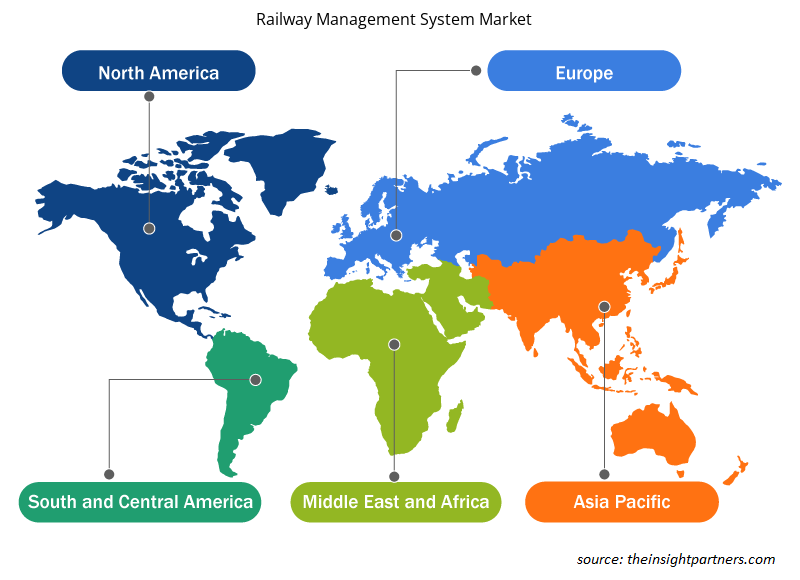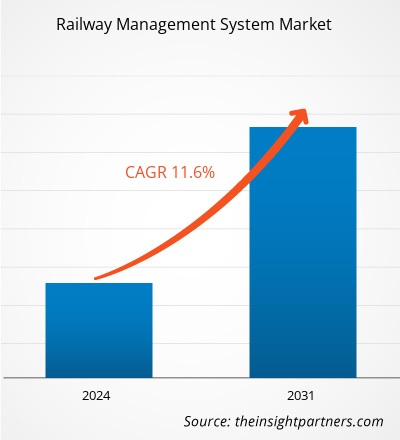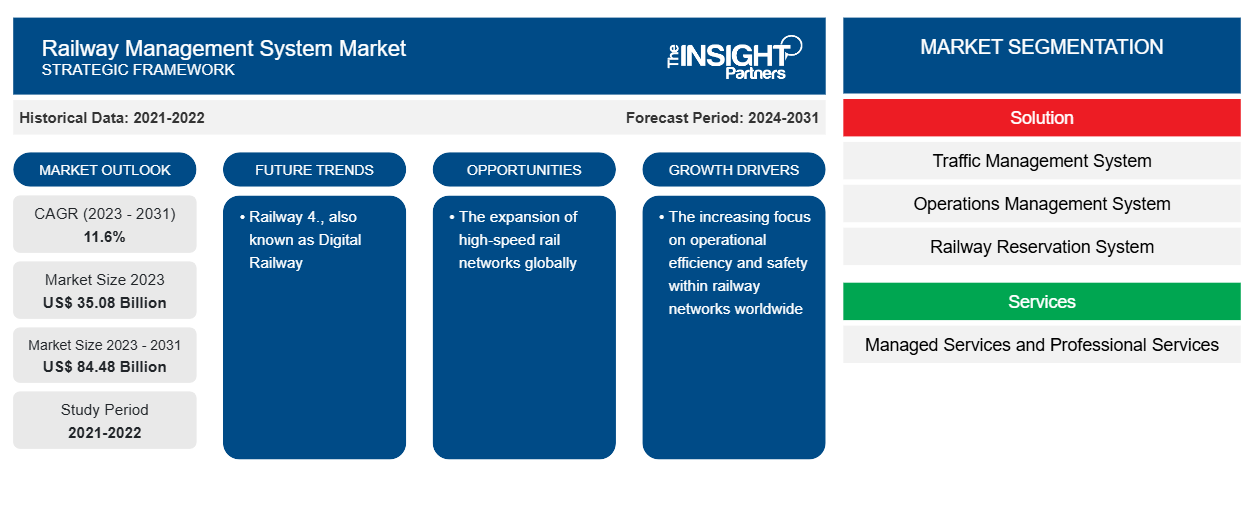Se proyecta que el tamaño del mercado de sistemas de gestión ferroviaria alcance los 84.480 millones de dólares estadounidenses en 2031, frente a los 35.080 millones de dólares estadounidenses en 2023. Se espera que el mercado registre una CAGR del 11,6 % entre 2023 y 2031. Es probable que el ferrocarril 4.0, también conocido como ferrocarril digital, siga siendo una tendencia clave en el mercado de sistemas de gestión ferroviaria.
Análisis del mercado de sistemas de gestión ferroviaria
El mercado de sistemas de gestión ferroviaria está creciendo gracias a diversas tendencias en el desarrollo de infraestructuras y la tecnología de transporte. Estos sistemas se centran en la eficiencia operativa, la mejora de la seguridad y la experiencia de los pasajeros por encima de otras funciones, como la monitorización en tiempo real y el mantenimiento predictivo. Varias tecnologías están impulsando el mercado, entre ellas la IA (inteligencia artificial), la IoT (Internet de las cosas) y la computación en la nube, que permiten la optimización y la gestión remotas de las operaciones ferroviarias. En general, el mercado de sistemas de gestión ferroviaria está creciendo y expandiéndose a nivel mundial, impulsado por el imperativo de mejorar la eficiencia, la seguridad y la sostenibilidad de los ferrocarriles.
Descripción general del mercado de sistemas de gestión ferroviaria
Un sistema de gestión ferroviaria abarca varios procesos y tecnologías para gestionar y operar de manera eficiente las redes ferroviarias. Incluye componentes como la gestión de carga, los sistemas de emisión de billetes , la información a los pasajeros, la programación de los trenes, la programación del mantenimiento y la supervisión de la seguridad. El sistema utiliza tecnologías avanzadas, como GPS, redes de comunicación y sensores de IoT para permitir la optimización de la planificación de rutas, garantizar la seguridad y el seguimiento en tiempo real de los trenes. Los servicios a los pasajeros se mejoran mediante la reserva de asientos, la reserva de billetes en línea y las actualizaciones en tiempo real de los horarios de los trenes. Además, las actividades de mantenimiento se racionalizan y se reducen los tiempos de inactividad y se mejora la eficiencia operativa general mediante el uso de técnicas de mantenimiento predictivo.
Personalice este informe según sus necesidades
Obtendrá personalización en cualquier informe, sin cargo, incluidas partes de este informe o análisis a nivel de país, paquete de datos de Excel, así como también grandes ofertas y descuentos para empresas emergentes y universidades.
-
Obtenga las principales tendencias clave del mercado de este informe.Esta muestra GRATUITA incluirá análisis de datos, desde tendencias del mercado hasta estimaciones y pronósticos.
Factores impulsores y oportunidades del mercado de sistemas de gestión ferroviaria
La creciente atención a la eficiencia operativa y la seguridad en las redes ferroviarias de todo el mundo
Con el aumento del volumen de pasajeros y mercancías, los operadores ferroviarios están recurriendo a sistemas de gestión avanzados para optimizar la programación de trenes, el mantenimiento de las vías y el rendimiento general de la red. Estos sistemas aprovechan tecnologías como sensores de IoT, análisis predictivos y monitoreo en tiempo real para mejorar la seguridad, minimizar los retrasos y reducir los costos operativos. Al mejorar la eficiencia y la confiabilidad, los sistemas de gestión ferroviaria ayudan a cumplir con las crecientes expectativas de los clientes y los estándares regulatorios.IoT sensors, predictive analytics, and real-time monitoring to enhance safety, minimize delays, and reduce operational costs. By improving efficiency and reliability, railway management systems help meet rising customer expectations and regulatory standards.
La expansión de las redes ferroviarias de alta velocidad a nivel mundial
Muchos países están invirtiendo en la modernización de su infraestructura ferroviaria para dar soporte a los trenes de alta velocidad, ofreciendo opciones de transporte más rápidas y sostenibles. Esta tendencia genera una demanda significativa de soluciones avanzadas de gestión ferroviaria capaces de gestionar operaciones complejas a velocidades más altas y garantizar una conectividad perfecta entre diferentes redes ferroviarias. A medida que los proyectos ferroviarios de alta velocidad continúan expandiéndose, el mercado de sistemas innovadores de gestión ferroviaria está preparado para un crecimiento sustancial. Por lo tanto, se prevé que la expansión de las redes ferroviarias de alta velocidad a nivel mundial presente nuevas oportunidades para los actores del mercado de sistemas de gestión ferroviaria durante el período de pronóstico.
Análisis de segmentación del informe de mercado del sistema de gestión ferroviaria
Los segmentos clave que contribuyeron a la derivación del análisis del mercado del sistema de gestión ferroviaria son el tipo de solución y de implementación.
- Con base en la solución, el mercado de sistemas de gestión ferroviaria se segmenta en sistema de gestión de tráfico, sistema de gestión de operaciones, sistema de reserva ferroviaria, sistema de información de pasajeros, sistema de gestión de mantenimiento y otros.
- En función de los servicios, el mercado de sistemas de gestión ferroviaria se segmenta en servicios gestionados y servicios profesionales.
- Por tipo de implementación, el mercado se segmenta en local y en la nube. El segmento de la nube tuvo una mayor participación de mercado en 2023.
Análisis de la cuota de mercado de los sistemas de gestión ferroviaria por geografía
El alcance geográfico del informe de mercado de sistemas de gestión ferroviaria se divide principalmente en cinco regiones: América del Norte, Asia Pacífico, Europa, Oriente Medio y África, y América del Sur/América del Sur y Central. En términos de ingresos, Europa representó la mayor participación de mercado de sistemas de gestión ferroviaria. En Europa, las redes ferroviarias establecidas y el enfoque en la eficiencia impulsan la demanda de sistemas de gestión avanzados que mejoren la seguridad, la puntualidad y la experiencia de los pasajeros. Países como Alemania y Francia lideran la adopción de tecnologías de vanguardia para el control, la señalización y el mantenimiento de trenes.
Perspectivas regionales del mercado de sistemas de gestión ferroviaria
Los analistas de Insight Partners han explicado detalladamente las tendencias y los factores regionales que influyen en el mercado de sistemas de gestión ferroviaria durante el período de pronóstico. Esta sección también analiza los segmentos y la geografía del mercado de sistemas de gestión ferroviaria en América del Norte, Europa, Asia Pacífico, Oriente Medio y África, y América del Sur y Central.

- Obtenga datos regionales específicos para el mercado de sistemas de gestión ferroviaria
Alcance del informe de mercado del sistema de gestión ferroviaria
| Atributo del informe | Detalles |
|---|---|
| Tamaño del mercado en 2023 | US$ 35.08 mil millones |
| Tamaño del mercado en 2031 | US$ 84,48 mil millones |
| CAGR global (2023 - 2031) | 11,6% |
| Datos históricos | 2021-2022 |
| Período de pronóstico | 2024-2031 |
| Segmentos cubiertos |
Por solución
|
| Regiones y países cubiertos |
América del norte
|
| Líderes del mercado y perfiles de empresas clave |
|
Densidad de actores del mercado de sistemas de gestión ferroviaria: comprensión de su impacto en la dinámica empresarial
El mercado de sistemas de gestión ferroviaria está creciendo rápidamente, impulsado por la creciente demanda de los usuarios finales debido a factores como la evolución de las preferencias de los consumidores, los avances tecnológicos y una mayor conciencia de los beneficios del producto. A medida que aumenta la demanda, las empresas amplían sus ofertas, innovan para satisfacer las necesidades de los consumidores y aprovechan las tendencias emergentes, lo que impulsa aún más el crecimiento del mercado.
La densidad de actores del mercado se refiere a la distribución de las empresas o firmas que operan dentro de un mercado o industria en particular. Indica cuántos competidores (actores del mercado) están presentes en un espacio de mercado determinado en relación con su tamaño o valor total de mercado.
Las principales empresas que operan en el mercado de sistemas de gestión ferroviaria son:
- Bombardier, Inc.
- Compañía de tecnología DXC
- EKE-Electronics Ltd
- Compañía General Electric
- Marca: Hitachi
- Huawei Technologies Co.; Ltd.
Descargo de responsabilidad : Las empresas enumeradas anteriormente no están clasificadas en ningún orden particular.

- Obtenga una descripción general de los principales actores clave del mercado de sistemas de gestión ferroviaria
Noticias y desarrollos recientes del mercado de sistemas de gestión ferroviaria
El mercado de sistemas de gestión ferroviaria se evalúa mediante la recopilación de datos cualitativos y cuantitativos posteriores a la investigación primaria y secundaria, que incluye publicaciones corporativas importantes, datos de asociaciones y bases de datos. A continuación, se incluye una lista de los avances en el mercado de los trastornos del habla y el lenguaje y las estrategias:
- En agosto de 2023, Toast, la plataforma tecnológica integral diseñada para restaurantes, anunció el lanzamiento de Toast Catering & Events, un nuevo producto totalmente integrado con el punto de venta (POS) de Toast para ayudar a los restaurantes a gestionar sin problemas los pedidos de catering de gran tamaño y la planificación de eventos. Toast Catering & Events admite pedidos de eventos de banquetes personalizables (BEO), herramientas de cumplimiento y funcionalidad de gestión de clientes potenciales. (Fuente: Toast, comunicado de prensa)
- En junio de 2021, FoodStorm, el proveedor líder mundial de software de catering, anunció el lanzamiento de su FoodStorm Kiosk, un quiosco físico de autoservicio para que los clientes de la tienda puedan realizar pedidos de catering, comida preparada, delicatessen y productos de panadería con un único backend administrado. (Fuente: FoodStorm, comunicado de prensa)
Informe de mercado sobre sistemas de gestión ferroviaria: cobertura y resultados
El informe “Tamaño y pronóstico del mercado del sistema de gestión ferroviaria (2023-2031)” proporciona un análisis detallado del mercado que cubre las siguientes áreas:
- Tamaño del mercado y pronóstico a nivel global, regional y nacional para todos los segmentos clave del mercado cubiertos bajo el alcance
- Dinámica del mercado, como impulsores, restricciones y oportunidades clave
- Principales tendencias futuras
- Análisis detallado de las cinco fuerzas de Porter y PEST y FODA
- Análisis del mercado global y regional que cubre las tendencias clave del mercado, los principales actores, las regulaciones y los desarrollos recientes del mercado.
- Análisis del panorama de la industria y de la competencia que abarca la concentración del mercado, el análisis de mapas de calor, los actores destacados y los desarrollos recientes
- Perfiles detallados de empresas
- Análisis histórico (2 años), año base, pronóstico (7 años) con CAGR
- Análisis PEST y FODA
- Tamaño del mercado, valor/volumen: global, regional y nacional
- Industria y panorama competitivo
- Conjunto de datos de Excel
Informes recientes
Informes relacionados
Testimonios
Razón para comprar
- Toma de decisiones informada
- Comprensión de la dinámica del mercado
- Análisis competitivo
- Información sobre clientes
- Pronósticos del mercado
- Mitigación de riesgos
- Planificación estratégica
- Justificación de la inversión
- Identificación de mercados emergentes
- Mejora de las estrategias de marketing
- Impulso de la eficiencia operativa
- Alineación con las tendencias regulatorias























 Obtenga una muestra gratuita para - Mercado de sistemas de gestión ferroviaria
Obtenga una muestra gratuita para - Mercado de sistemas de gestión ferroviaria